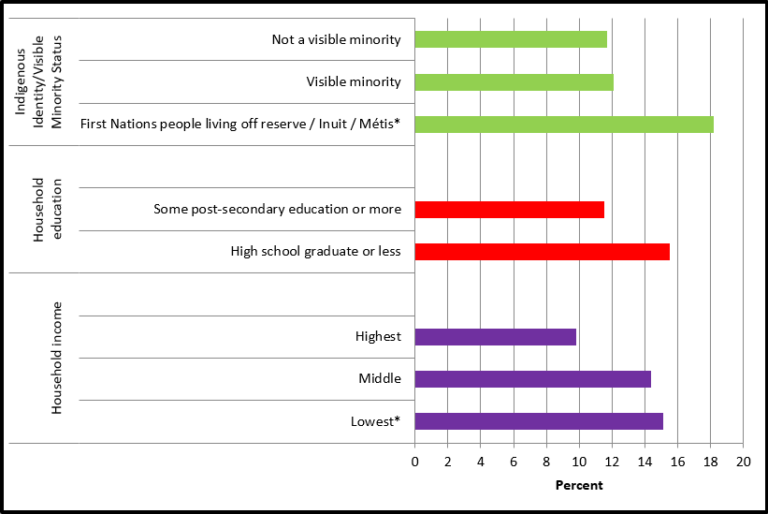5.1.5 Percentage of Canadian children and youth aged 6 to 17 years who are obese by household income, household education and Indigenous Identity and Visible Minority status, Canada, 2009-2013

Notes:
*Interpret with caution
Obesity prevalence is defined as a Body mass index (BMI) score equal to 30.0 or above, based on measured height and weight
Source: CICH graphic created using data adapted from Towards a Healthier Canada – Health Inequalities Data Table, Health Inequalities Data Tool, A joint initiative of the Public Health Agency of Canada, the Pan-Canadian Public Health Network, Statistics Canada and the Canadian Institute of Health Information. Data from the Canadian Health Measures Survey (CHMS; 2009-2013).
Children adversely affected by the social determinants of health are at higher risk of having obesity.
Children and youth who live in the lowest income families are more likely to be obese than are those who live in the highest income families – 15% versus 10% respectively.
Children who live in households with lower levels of education are more likely to be obese than those with higher levels of education.
In 2009-2013, 16% of Canadian children and youth aged 6 to 17 years who lived in households where the household education level was high school or less were obese compared with 12% of children in households where the household education level was some post-secondary education.
18% of First Nations children and youth aged 6 to 17 years were obese in 2009-2017 compared with 12% of children who were visible minority and 12% of children who were not a visible minority.
Implications
Living in adverse or deprived conditions can affect the developing fetus in ways that may result in obesity that are not about the quality of food. Psychosocial stress or malnutrition in pregnant women and the psychosocial stress of poverty on the child and caregiver in the first few years of life can also turn on a switch that leads to a higher adult BMI.1,2 Childhood trauma can also lead to obesity in adulthood.3
1Lima RPA, Hayashi DN, Lima KQDF, Gomes NIG, Ribeiro MR, et al. (2017) The Role of Epigenetics in the Etiology of Obesity: A Review. J Clin Epigenet. 3:41.
2Campbell MK. Biological, environmental, and social influences on childhood obesity. Pediatric Research volume 79, pages 205–211 (2016) |
3Heerman, W. J., Krishnaswami, S., Barkin, S. L., & McPheeters, M. (2016). Adverse family experiences during childhood and adolescent obesity. Obesity, 24(3), 696-702.
